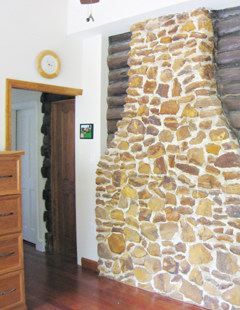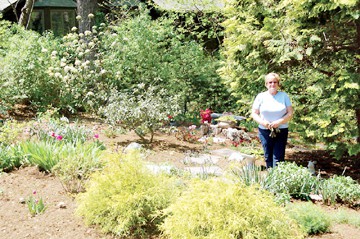Behind Closed Doors
Quirky. Eccentric. Eclectic. That’s how people describe Scientists’ Cliffs, the private community on Calvert’s famous cliffs. The twisting dead-end lanes and the collection of cabins lining them have been quietly hidden from public view for the last 74 years. All five entrances to the community are labeled private, discouraging sightseers and adding further mystique to the historic neighborhood.
Come May 7, the era of privacy closes, and for that one day, the community opens to the Maryland Home and Garden Tour. Pilgrims are welcomed into places with names like Old Hickory, Cliff House, Chestnut Cabin, and Villa of Reduced Circumstances.
You’ll need a ticket to get in, but a doctorate isn’t required.
Truth in Naming
Tucked into wooded hillsides and perched on cliffs overlooking Chesapeake Bay, the tightly knit community known as The Cliffs has the distinction of being well-known but rarely seen. Such privacy evokes myths. One is that only scientists are allowed to live there; mere mortals are locked out.
There is a grain of truth to the story.
The private community was first established in 1935 by George ‘Flippo’ Gravatt and his wife Annie, both plant pathologists with the U.S. Department of Agriculture. An expert on the chestnut tree blight, the Gravatts considered Calvert County as a possible preserve for the endangered tree.
“Gravatt was first and foremost a scientist, but he had a developer’s sensibility. He saw this place not too far from D.C. or Beltsville had potential,” says Carl Fleischhauer, a Library of Congress program officer and member of the committee that wrote a history of Scientists’ Cliffs for the community. Fleischhauer and wife Paula Johnson have lived in Scientists’ Cliffs since 1984.
Depression-era prices allowed the scientist/developer to purchase more than 200 acres that would become Scientists’ Cliffs. The year was 1935. The first cabin built was their own. Chestnut Cabin is constructed from chestnut trees felled from the blight.
By 1937, a dozen or so more cabins were built by extended family and colleagues. These cabins were used primarily as rental properties. The renters were hand-picked as they were considered potential buyers.
The Gravatts’ dream was a community of people who shared common interests and concerns. In 1937, they formed an association so their dream could be reality.
“The 1937 Articles of Incorporation articulate community values first and relegate the need to own, hold, and manage … real and personal property to the end of a very long sentence,” Fleischhauer says. “The corporation’s main purpose is to promote an interest in the natural sciences to be accomplished by means of a botanical garden; arboretum; preservation of wild areas; exploration and preservation of fossil deposits, Indian relics, plants, Bay life, and other things of local interest; lectures; field trips.”
Gravatt’s idea was indeed that only scientists would be eligible for membership in the community. Membership was later broadened to include all college graduates and then extended to those who had achieved recognized status in their profession without college degrees.
  |
The first residents included plant pathologists, chemists, bacteriologists, geologists, three attorneys and a number of other occupations, including diplomats.
E.A. Hollowell was one of those first scientist residents.
“My father started bringing us here in 1937,” Jim Hollowell recalls. “He was a plant geneticist from USDA in Beltsville.”
The elder Hollowell’s work followed him south, where he worked on wide crosses of rhododendrons and azaleas.
“He wanted a golden rhododendron,” Jim says. “But he died four years into the process that usually takes at least nine years. He wasn’t able to finish, but he did successfully cross a native flame azalea with a mollis azalea, and got some wonderful colors out of that cross.”
Some of E.A. Hollowell’s azaleas can be seen on the tour in the garden of Jim and Connie Hollowell, who moved into the community 13 years ago. In their Easterbell Road garden, Hollowell tends not only his inherited gems but also 90-plus other varieties, dominated by Delaware Valley white.
“I wanted a white swath circling the steps,” Hollowell says. “I started out with 40, and I have many more today.”
Building a Community
Scientists’ Cliffs expanded after World War II. Admitted to the club were more than a dozen attorneys, retired military families and architects, plus a patent examiner, a physician and an urban planner. Though now diverse in occupations, the residents still share broad interests in science and preservation, keeping with the Gravatts’ original intent.
The Cliffs was established as a seasonal community, but in 1943 the first year-round resident moved in. As the community grew, the rustic camp feeling remained, thanks to a restrictive covenant that required all houses within the community to have a wooden exterior, giving the homes — or cabins, as they are called — a distinctively rustic look.
The original cabins were built with logs harvested and milled on the property, to blend the community in a symbiotic relationship with the land. Log construction was also inexpensive.
  |
The modern cabins have maintained that rustic feel. Some of the originals remain pretty much the same as the day they were built, others have been renovated and new cabins constructed — all with a tip of the hat toward the Scientists’ Cliffs tradition.
Tom and Mary Kirby’s Cliff House on Elm Road is one of the original cabins. Or at least part is.
“We bought an old cabin five years ago,” Tom Kirby tells Bay Weekly. “It was built in the late 1930s but didn’t appear on the land records until 1957, when it was remodeled for fulltime occupancy. Until then, it was really more of a tent-cabin.”
The Kirbys needed more space and updates to the cabin, but they couldn’t come up with an architectural solution. Not wanting to tear down the old log building, they came up with a novel idea: Build the new house around the original.
“The preserved original cabin is our living room,” Kirby says. “We kept the original exterior chimney inside, and it’s a feature in the office and guest room. An original exterior wall is one interior wall of the office.”
The unusual renovation is not the only standout feature of this home on the tour. It sits on the edge of a cliff at one of the highest points in the community. “It’s 105 feet down to the water,” Kirby says. “That’s one of the biggest reasons we bought the house.”
Patty Brosmer moved into her Atropa Road cabin just a year ago. Her cabin is a newer one, built in 1980, but her time in the Cliffs predates her home.
“My grandparents had a summer cabin, and I spent my summers here,” Brosmer says. “I always dreamed of living here.”
A single parent, Brosmer was a serial renter until the real estate market turned in her favor. Most of the houses in the Cliffs were out of her price range. Her cabin “didn’t show well. It was covered with vines. Thankfully,” she says, “I spotted the potential.”
 “I like to have something blooming early spring to late fall,” Helen Didion says. When she and her husband David purchased the home in 2000, it was surrounded by vines, bamboo and mud flats. “We couldn’t even walk around back,” Didion says. “It was wild.” |
Brosmer went to work immediately, removing a wall to open the kitchen to the living area, painting the dark paneling to lighten the space and clearing out the yard.
“This spring I was surprised by hundreds of daffodils,” Brosmer says.
The now-cheery home is furnished with furniture inherited from her grandparents plus treasures she found while scouring flea markets and auctions. Brosmer’s guests get special treatment. The guest room was designed from a photo spread in a ritzy glossy magazine but without a magazine’s budget.
As in other Bay-front communities, the lots in The Cliffs are small. Size didn’t keep Helen Didion from planting a garden spanning the seasons around her Cedar Road cabin. When she and her husband David purchased the home in 2000, it was surrounded by vines, bamboo and mud flats.
“We couldn’t even walk around back,” Helen Didion says. “It was wild.”
The Didions installed a stone walkway around the house, patio and driveway. The garden is a work in progress.
“I like to have something blooming early spring to late fall,” Didion says. “I like to bring birds and butterflies into the garden.”
Spring bulbs, forsythia, mock orange, lilac, peonies and camellia color spring. Come summer, St. John’s wort, roses, purple coneflowers and black-eyed Susan’s take over.
“I add pots for blooming annuals for splashes of color,” Didion says. “We planted Steppables [underfoot groundcover] between the stones in the walkway.”
Didion has been gardening since a child, helping her father in his English garden, but this is her first time on a garden tour.
“I like to share,” Didion says. “I just hope everyone enjoys it as much as we do.”
Preserving the Dream
The Gravatts’ early vision for Scientists’ Cliffs was for a protected place where the unique environment could be studied. The tall cliffs along the edge of the Bay, part of the Calvert Formation, contain one of the world’s richest fossil deposits from the Miocene period. Carcharodon megalodon teeth are common. These sharks’ teeth collected on the beach at the foot of the cliffs are sometimes embedded in the mortar in the early stone chimneys.
Later residents honored the founder’s original intent. Scientists’ Cliffs is the only community in Maryland that maintains a museum of fossils collected on its beach. Housed in the Gravatts’ original Chestnut Cabin, the museum was installed in the 1950s.
In 1963, Bending Bough nursery was begun by resident Joseph Showalter as a way to pursue his horticultural interests and to “enhance the beauty of Scientists’ Cliffs.”
In 1986, development threatened the surrounding woods and farms. Determined to keep alive the spirit and continuity of the original founders, Scientists’ Cliffs bought 436 acres and formed the American Chestnut Land Trust. Now more than 4,000 acres are in preservation through the Trust.
Today’s cliff dwellers still “reflect higher aspirations, shared ideology and love of place,” says Fleischhauer. “Most of us who live here feel that those original threads remain.”
Plan Ahead to Go
Saturday, May 7, 10am-5pm. Park opposite 2420 Aspen Rd., Port Republic, for free minibus shuttle; no private cars will be permitted to enter any of the community gates. rsvp; $30; day-of tickets sold only at the parking field: www.brownpapertickets.com/event/155886.
Gourmet boxed luncheon served at Scientists’ Cliffs Community House 11:30am-2:30pm by pre-paid reservation before April 30. $15 payable to Calvert Garden Club and mailed to Carol Frederick, 530 Small Reward Rd., Huntingtown, MD 20639.
Info and directions: http://www.mhgp.org/?p=calvert-2011; Joyce Fletcher at 410-535-5569.
